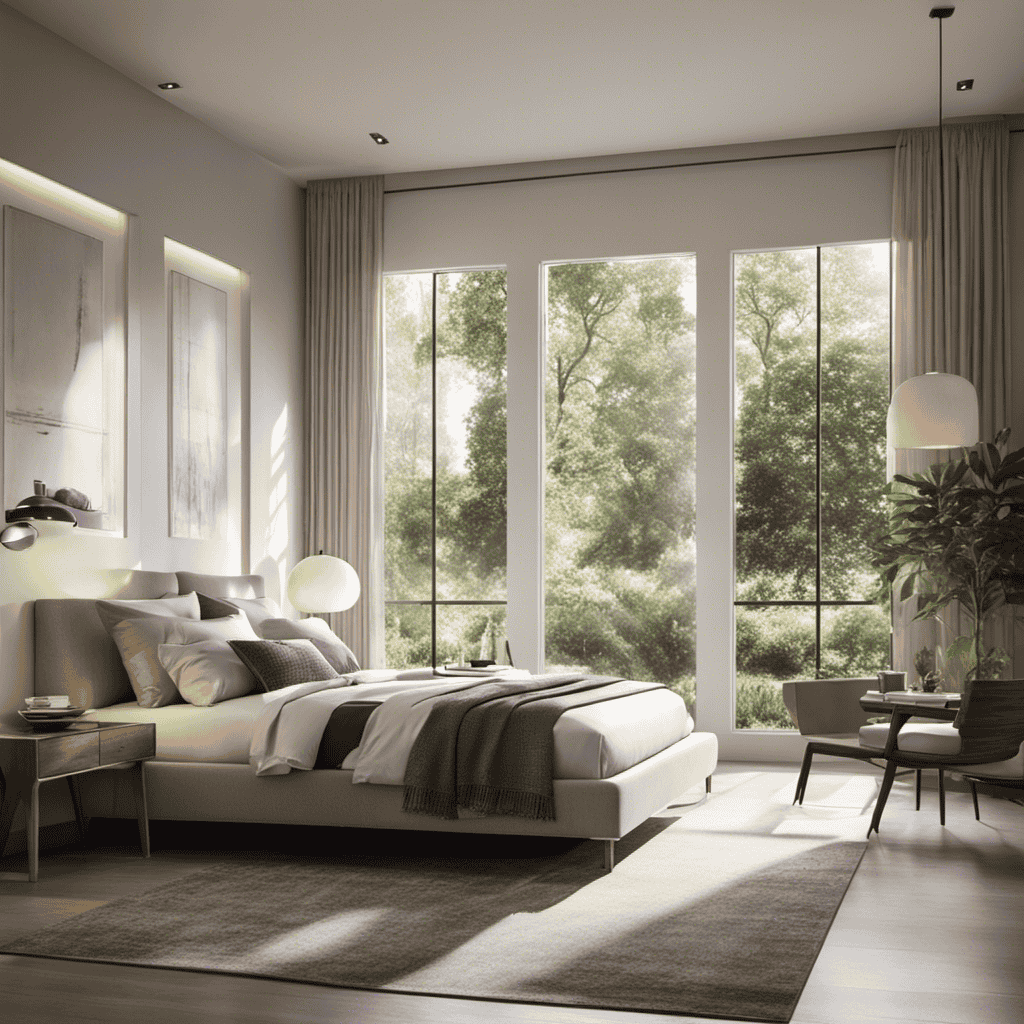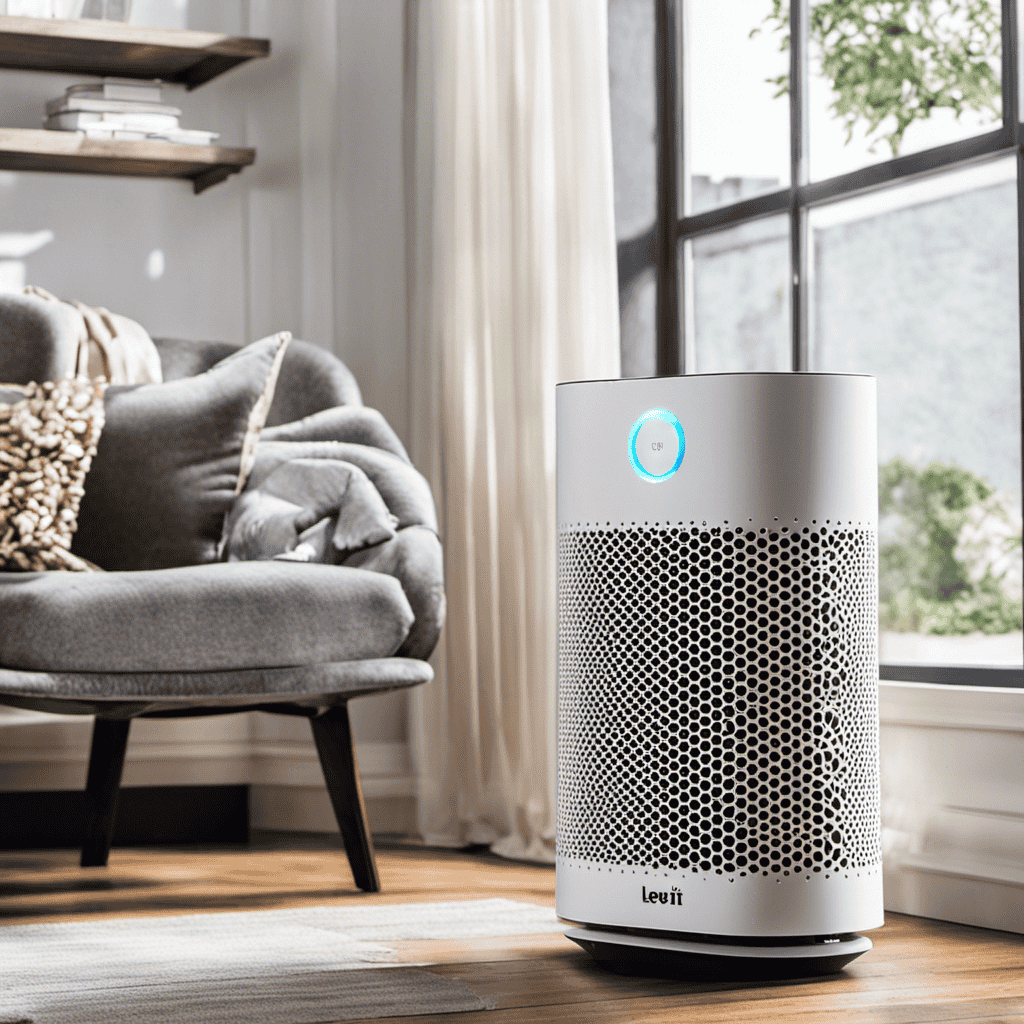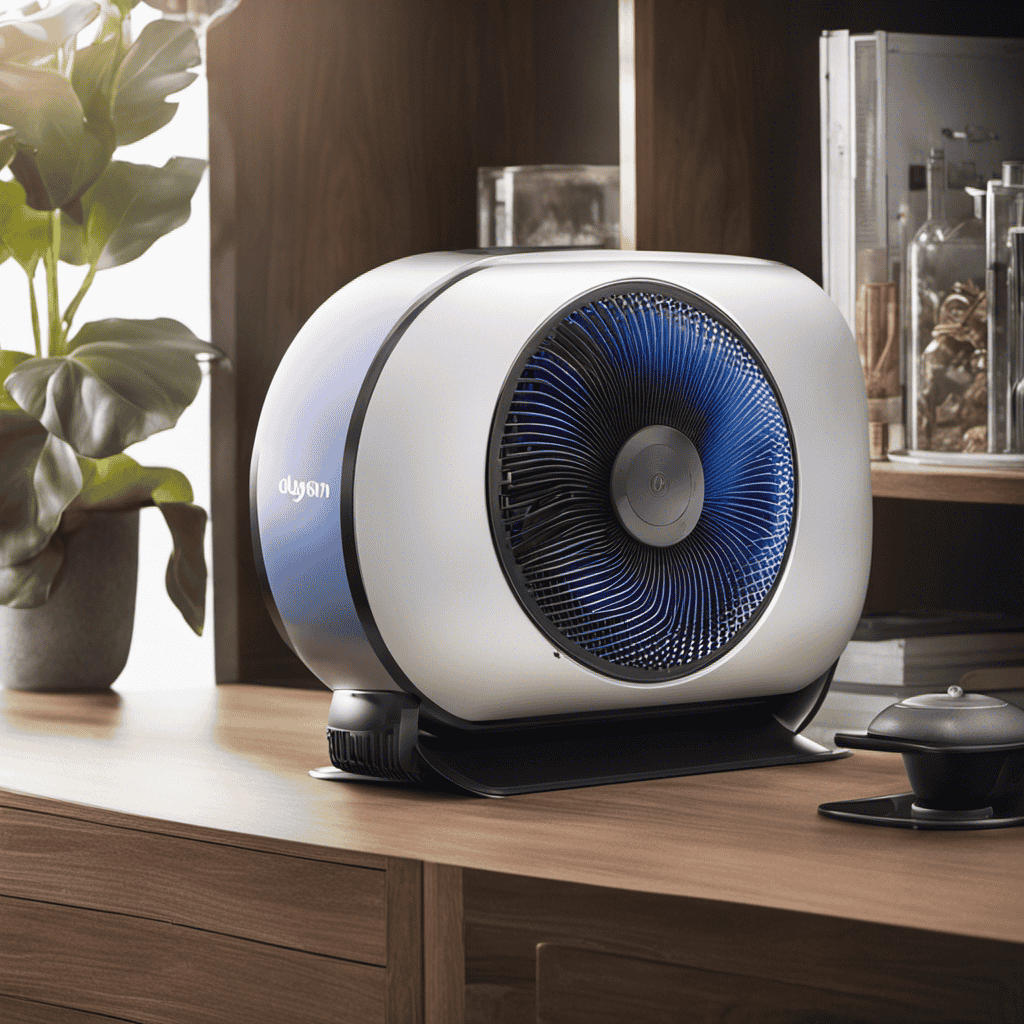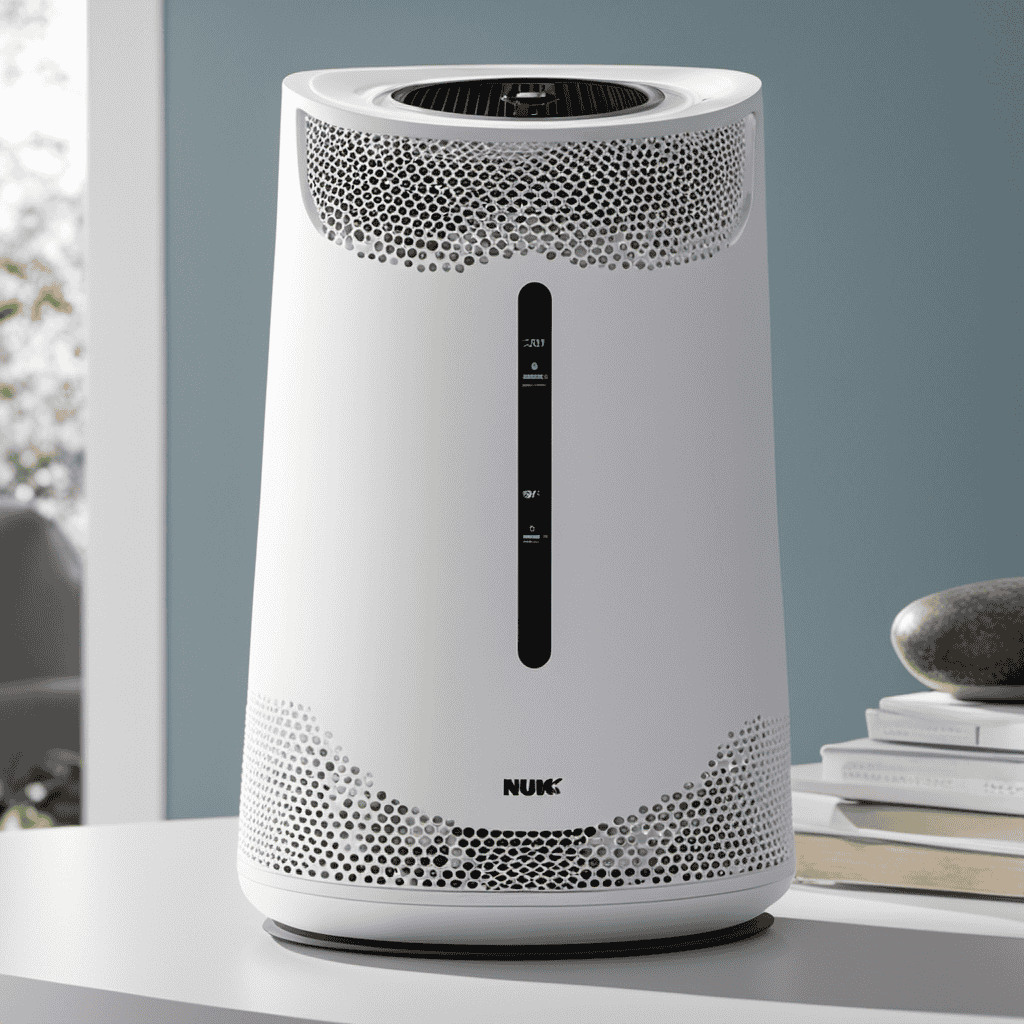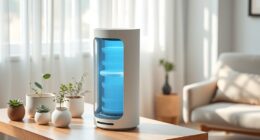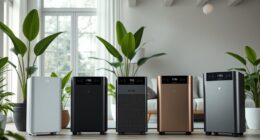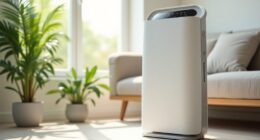Have you ever thought about the process of manufacturing air purifiers as someone who enjoys breathing in fresh, clean air every day?
In this article, I will take you on a journey behind the scenes, where I’ll explain the meticulous process of creating these essential devices.
From understanding the importance of air purifiers to exploring the different types available, we’ll delve into the world of air purifier manufacturing.
So, let’s dive in and discover the fascinating intricacies of bringing clean and healthy air into our lives.
Key Takeaways
- Air purifiers improve indoor air quality by removing pollutants such as dust, pet dander, pollen, and smoke particles.
- The main components of an air purifier include a fan, filter, and housing, which work together to draw in air, remove pollutants, and direct airflow.
- The manufacturing process involves sourcing components from trusted suppliers, skilled assembly by technicians, efficiency testing, and energy consumption analysis.
- Rigorous quality control measures are implemented to ensure product safety, compliance with certification standards, and ongoing monitoring of manufacturing processes.
The Importance of Air Purifiers
Air purifiers are essential for improving indoor air quality. They offer numerous benefits, especially in areas where air pollution is a concern.
Air pollution can have a significant impact on our health, leading to respiratory problems, allergies, and even more severe conditions like asthma. By using air purifiers, we can effectively remove pollutants such as dust, pet dander, pollen, and smoke particles from the air we breathe.
These devices work by filtering the air and trapping these harmful particles, ensuring that the air we breathe is clean and safe. Understanding the components of an air purifier is crucial in maximizing its effectiveness.
Let’s explore how these components work together to provide us with clean and healthy air.
Understanding Air Purifier Components
The main parts of an air purifier include a fan, a filter, and a housing to contain these components. These three elements work together to ensure the effective purification of indoor air.
Here is a breakdown of their roles:
-
Fan: The fan is responsible for drawing in air from the surrounding environment and pushing it through the filter. It creates the necessary airflow for the purification process.
-
Filter: The filter is the heart of the air purifier. It traps and removes various pollutants, such as dust, pollen, pet dander, and even harmful gases. Regular air purifier maintenance involves cleaning or replacing the filter to maintain optimal performance.
-
Housing: The housing provides a protective enclosure for the fan and filter. It also helps to direct the airflow and prevents any leakage of unfiltered air.
Understanding the components of an air purifier is essential for air purifier maintenance and reaping the benefits of cleaner indoor air. With a grasp of these components, we can now explore the manufacturing process of air purifiers.
The Manufacturing Process of Air Purifiers
To understand how air purifiers are made, you’ll be interested in the step-by-step manufacturing process. First, the components such as filters, fans, and control panels are sourced from trusted suppliers. These components are then assembled on a production line, where skilled technicians carefully put them together. Once assembled, the air purifiers undergo efficiency testing to ensure they meet the required standards. This involves measuring the purifier’s ability to remove pollutants from the air. Additionally, energy consumption analysis is conducted to determine the power usage of the device. This helps in assessing the environmental impact and efficiency of the air purifier. Finally, the air purifiers are packaged and prepared for distribution to customers around the world.
| Step | Description |
|---|---|
| 1 | Sourcing components |
| 2 | Assembly |
| 3 | Efficiency testing |
| 4 | Energy consumption analysis |
Quality Control in Air Purifier Production
When it comes to ensuring product safety in air purifier production, there are several key points to consider.
One of the most important is implementing rigorous quality control measures throughout the manufacturing process.
This involves closely monitoring each step, from sourcing materials to assembly, to ensure that the final product meets the highest safety standards.
Ensuring Product Safety
Ensuring product safety is a vital step in the manufacturing process of air purifiers. As a manufacturer, I understand the importance of adhering to product certification and safety regulations. Here are three key aspects that we focus on to ensure the safety of our air purifiers:
-
Compliance with Product Certification: We ensure that our air purifiers meet the necessary product certification standards, such as UL (Underwriters Laboratories) or CSA (Canadian Standards Association). This certification ensures that our products have undergone rigorous testing and meet safety requirements.
-
Quality Control Testing: We conduct thorough testing throughout the manufacturing process to identify any potential safety issues. This includes testing for electrical safety, air quality emissions, and noise levels, among other factors. These tests help us identify and resolve any potential safety concerns before the products reach the market.
-
Ongoing Safety Monitoring: Once our air purifiers are on the market, we continue to monitor their safety performance. We stay informed about any safety concerns or updates to safety regulations and promptly address any issues that may arise.
Monitoring Manufacturing Processes
As a manufacturer, I can monitor my manufacturing processes to ensure efficiency and quality control. By closely monitoring each step of the production line, I can identify any bottlenecks or inefficiencies that may be causing delays or increasing costs.
This allows me to make necessary adjustments to streamline operations and reduce manufacturing costs. For example, I can track the time it takes for each task to be completed and identify any areas where there is a significant delay. By addressing these delays, I can improve overall efficiency and reduce the amount of time and resources required to manufacture each air purifier.
Additionally, monitoring the quality of the raw materials and the finished products ensures that only the highest quality products are being produced, further reducing costs associated with rework or customer returns.
Different Types of Air Purifiers
When it comes to air purifiers, understanding the different filter technologies is essential.
In this discussion, we will delve into the various filter technologies used in air purifiers and explain how they work.
Additionally, we will analyze the pros and cons of each filter technology to help you make an informed decision when choosing an air purifier.
Filter Technologies Explained
Filter technologies, such as HEPA and activated carbon, play a crucial role in air purifiers. These advancements in filter technology have greatly improved the effectiveness of air purifiers in removing pollutants from the air, resulting in better indoor air quality.
Here are three key ways in which filter technology advancements have had a positive impact on indoor air quality:
-
Increased filtration efficiency: HEPA filters, for example, are capable of capturing particles as small as 0.3 microns with an efficiency of 99.97%. This means that even the tiniest particles, such as allergens, bacteria, and viruses, can be effectively removed from the air.
-
Removal of harmful gases and odors: Activated carbon filters have the ability to absorb and trap pollutants like volatile organic compounds (VOCs), smoke, and unpleasant odors. This ensures that the air you breathe is not only free from particles but also from harmful gases.
-
Reduction in airborne allergens: Filter advancements have enabled air purifiers to effectively capture and remove common allergens like pollen, pet dander, and dust mites. This is especially beneficial for individuals with allergies or asthma, as it helps alleviate symptoms and improve overall respiratory health.
Overall, the continuous advancements in filter technology have significantly improved the ability of air purifiers to remove pollutants from the air, leading to cleaner and healthier indoor environments.
Pros and Cons Analysis
One of the pros of using advanced filter technology in air purifiers is the increased efficiency in capturing and removing harmful particles and allergens from the indoor air. These advanced filters are designed to trap even the smallest particles, such as dust, pet dander, mold spores, and pollen. They can also capture volatile organic compounds (VOCs) and odors, improving the overall air quality in your home.
Additionally, these filters are often washable or replaceable, making maintenance easier and more cost-effective.
However, there are some cons to consider as well. Advanced filter technology can be more expensive than traditional filters, and they may require more frequent replacement or cleaning. It’s also important to note that while these filters can effectively remove contaminants, they cannot eliminate all indoor air pollutants.
Therefore, it’s essential to have a well-ventilated space and address other sources of air pollution for optimal effectiveness.
Choosing the Right Air Purifier for Your Needs
To find the right air purifier for your needs, start by considering the size of the room you want to purify. Here are some key factors to consider:
-
Air purifier performance: Look for models with high Clean Air Delivery Rate (CADR) ratings, which indicate their effectiveness in removing airborne pollutants. Consider the specific contaminants you want to target, such as dust, pollen, or pet dander, and choose a purifier that is designed to tackle those.
-
Cost effectiveness comparison: While it’s important to consider the initial cost of the air purifier, also factor in long-term costs like replacement filters and energy consumption. Look for models that offer good value for money, with efficient filters that last longer and consume less energy.
-
Room size compatibility: Different air purifiers are designed for different room sizes. Make sure to choose one that is suitable for the square footage of your room to ensure optimal performance.
By considering these factors, you can find an air purifier that meets your specific needs in terms of performance and cost effectiveness.
Now, let’s explore the environmental considerations in air purifier manufacturing.
Environmental Considerations in Air Purifier Manufacturing
Consider the impact on the environment when choosing an air purifier, as factors such as energy consumption and filter replacement can contribute to a product’s overall sustainability. Sustainable practices and energy efficiency are key considerations in the manufacturing of air purifiers.
Manufacturers are increasingly adopting sustainable practices to minimize their environmental impact. This includes using energy-efficient technologies in the production process and designing air purifiers that consume less energy while still effectively purifying the air. Additionally, manufacturers are focusing on developing air purifiers with replaceable filters that are made from recyclable materials.
Innovations in Air Purifier Technology
The latest innovations in air purification technology have significantly improved the efficiency and effectiveness of filtering airborne pollutants. These advancements in air purifiers offer a glimpse into the future of air purification, providing cleaner and healthier indoor air.
Here are three notable advancements in air purifier technology:
-
High-efficiency particulate air (HEPA) filters: HEPA filters have been a standard in air purifiers for some time now, but recent advancements have made them even more effective at capturing ultrafine particles as small as 0.3 microns. This means they can effectively trap allergens, dust, pet dander, and even viruses, providing cleaner air for allergy sufferers and those with respiratory conditions.
-
Smart sensors and automation: Many modern air purifiers are equipped with smart sensors that can detect changes in air quality and automatically adjust the purification settings accordingly. This ensures that the air is always being filtered at the optimal level, without the need for manual adjustments.
-
Multi-stage filtration systems: Traditional air purifiers often relied on a single filter to capture pollutants. However, newer models now come with multi-stage filtration systems that use a combination of different filters to target specific pollutants. For example, activated carbon filters can effectively remove odors and volatile organic compounds (VOCs), while photocatalytic filters can break down harmful chemicals and gases.
These advancements in air purifier technology not only enhance the air purification process but also make it more convenient and efficient. With ongoing research and development, the future of air purification looks promising, with even more advanced features and capabilities to improve indoor air quality.
Maintenance and Care for Air Purifiers
Regularly cleaning and replacing the filters in your air purifier is essential for maintaining its efficiency and ensuring that it continues to provide clean and healthy indoor air. One of the most important maintenance tips for air purifiers is to follow the manufacturer’s instructions on how often to clean or replace the filters.
Most air purifiers have a pre-filter that captures larger particles, such as dust and pet hair. This pre-filter should be cleaned or replaced every month or two. Additionally, the HEPA filter, which is responsible for removing smaller particles like allergens and bacteria, should be replaced every six to twelve months.
Neglecting filter maintenance can lead to common air purifier problems, such as reduced effectiveness and increased energy consumption. Therefore, it is crucial to prioritize regular filter cleaning and replacement to ensure optimal performance and clean indoor air.
Frequently Asked Questions
How Long Does the Manufacturing Process of an Air Purifier Typically Take?
Typically, the manufacturing process of an air purifier takes a few weeks. Various techniques are used, such as assembling components, testing, and quality control. It’s important to consider the impact of air purifiers on energy consumption during production.
Are Air Purifiers Noisy When They Are in Operation?
Air purifiers can vary in noise levels during operation. Some models are designed to be quiet, while others may produce more noticeable noise. It’s important to consider the effectiveness of the purifier in improving air quality as well.
Can Air Purifiers Improve the Quality of Air in a Large Room or Only in Small Spaces?
Yes, air purifiers can improve the quality of air in large rooms. They remove pollutants, allergens, and odors, creating a healthier environment. The benefits of using air purifiers in large spaces include better respiratory health and reduced allergy symptoms.
Are There Any Health Risks Associated With Using Air Purifiers?
There are potential health risks associated with using air purifiers, such as ozone emissions and inadequate maintenance. It is important to research and choose an air purifier that is effective and to regularly clean and replace filters to ensure optimal performance.
Can Air Purifiers Eliminate Odors From Cooking or Smoking?
Air purifiers can effectively eliminate odors from cooking or smoking, making the air smell fresh and clean. They are also beneficial for those with allergies or pets, as they help remove allergens and pet odors.
Conclusion
After researching and understanding the manufacturing process of air purifiers, it is clear that these devices play a crucial role in improving indoor air quality. The quality control measures in place ensure that the air purifiers produced meet high standards.
With different types available, it is important to choose the right one for individual needs. Additionally, environmental considerations are taken into account during manufacturing to minimize the impact on the environment.
The continuous innovations in air purifier technology contribute to their effectiveness. Regular maintenance and care will ensure optimal performance.
In conclusion, air purifiers are essential for creating a healthy and clean indoor environment.

